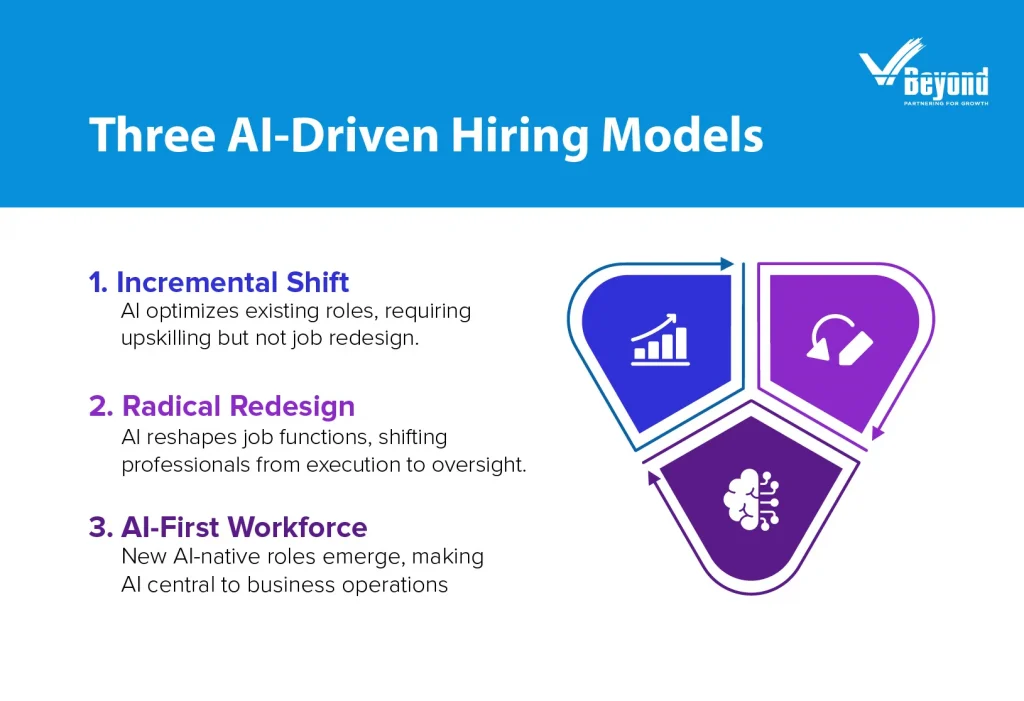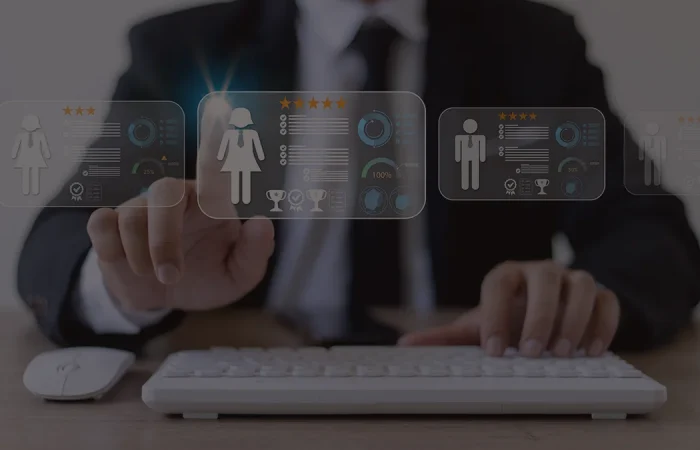1. AI as a workforce partner, not replacement: AIs is not replacing professionals—it’s augmenting them. The most in-demand workers are those who can collaborate with AI to enhance productivity, creativity, and strategic thinking, giving rise to a new class of AI-augmented workers.
2. Evolving Hiring Models for AI Integration: Businesses must rethink hiring by choosing from three approaches: embedding AI into existing roles, redesigning jobs for AI-human collaboration, or creating new AI-native roles. Success depends on aligning talent strategies with how AI functions in the organization.
3. Transforming Layoffs into Strategic Transitions: As AI alters workforce needs, companies should shift from abrupt layoffs to proactive workforce reinvention—offering upskilling, extended transition periods, and alumni networks to support dignified exits and future re-engagement.
Introduction
The workplace is no longer divided between humans and machines—it is evolving into a space where professionals and AI work in tandem. This reflects the rise of the AI-augmented workforce as part of broader AI-ready job market trends. Financial analysts interpret AI-driven risk models, legal teams collaborate with AI for contract analysis, and marketers refine AI-generated consumer insights. As AI takes on more tasks, the definition of expertise is shifting, indicating workforce transformation with AI, including a change in the current hiring model. Companies are no longer just looking for skills—they are looking for professionals who can adapt, collaborate with AI, and evolve in roles that are constantly being redefined.
The question is no longer who replaces whom, but who can evolve fastest in a workplace where AI is an active participant.
The Shift to AI-Augmented Work: What’s Changing and Why It Matters
In its October 2024 report, S&P highlights a critical transformation in the white-collar job market—hiring in professional services has slowed, layoffs are rising, and AI-driven efficiencies are reshaping workforce structures. In September 2024 alone, 497,000 jobs were shed in professional and business services, marking the highest layoffs in the sector in nearly two years. Despite past job growth, employment in this sector has now stalled, and many companies are reconsidering how they structure their workforce in response to economic conditions and advancing technology.
While this might seem like an outright contraction, it signals something deeper: a shift in how work is being done. Thought leader Josh Bersin’s research, Rise of the Superworker,” frames AI as a workforce multiplier rather than a disruptor. Instead of replacing employees, AI is enhancing their capabilities—allowing professionals to boost efficiency, automate repetitive tasks, and focus on higher-value work. He describes a new class of workers—the “Superworker”—who leverage AI to scale their productivity, creativity, and strategic impact.
This shift demands a fundamental rethinking of hiring models and workforce strategies. As businesses integrate AI, traditional job roles are evolving, and hiring must prioritize AI proficiency, adaptability, and cross-functional expertise. The challenge is no longer just about filling positions—it’s about identifying and developing AI-augmented professionals who can thrive in this new era.
How Companies Should Approach AI-Augmented Workforce Hiring Strategies
This shift demands a fundamental rethinking of hiring models and workforce strategies. As businesses integrate AI, traditional job roles are evolving, and workforce hiring must prioritize AI proficiency, adaptability, and cross-functional expertise. But before companies can develop effective hiring strategies, they need to confront a more pressing question: what does AI actually mean for their workforce?
AI’s impact on jobs isn’t uniform—it varies by industry, business model, and existing workforce capabilities. Companies can’t afford to take a one-size-fits-all approach as roles transform, leading to the rise of new ones. But how do businesses decide what needs to change?
A. Reframing Workforce Models for AI: What Needs to Be Discussed First?
Most businesses acknowledge that AI is transforming work, yet few have a structured framework for what that means for their workforce. The challenge is not just integrating AI but understanding its role within the organization. Professional hiring for AI-readiness requires more than adding “AI proficiency” to job descriptions.
Before making hiring decisions and undertaking workforce transformation with AI, businesses must confront fundamental questions: Does every job need AI integration? Should AI be embedded in existing roles or create new ones? How much of a given function should remain human-led?
AI’s role in the workforce varies significantly based on three key factors:
- Industry-Specific Needs: AI adoption is not uniform. A financial firm leveraging AI for algorithmic trading has vastly different needs from a media company optimizing AI for content personalization.
- Existing Workforce Capabilities: Some companies already have a digitally fluent workforce that can seamlessly adopt AI, while others require significant upskilling before AI can be meaningfully integrated.
- Regulatory and Ethical Considerations: AI adoption in finance or healthcare comes with high compliance stakes, requiring careful oversight. In creative industries, AI’s role must balance efficiency with originality.
Despite these variations, most companies continue to approach AI hiring within traditional job structures, missing critical questions that should guide their strategy:
- Does this role even need to exist in its current form? AI is reshaping workflows—some tasks can be automated, while others need human oversight.
- Should we prioritize hiring for new AI-centric skill sets rather than adapting old roles? AI-first companies are rethinking job descriptions entirely, rather than making incremental updates.
- Where does human oversight remain indispensable? AI is powerful, but it cannot fully replace human judgment, creativity, and ethical decision-making.
Building a Workforce Strategy for AI
Instead of defaulting to generic AI workforce strategies, businesses must first determine AI’s true function within their organization. This means answering three key strategic questions:
- What is AI’s role in our workforce?
- Is it an efficiency tool? A strategic decision-making assistant? A fully autonomous system? Defining AI’s purpose influences hiring priorities.
- How will humans and AI collaborate?
- Will AI act as a decision validator (where humans confirm AI recommendations)? A collaborative tool (where AI enhances human workflows)? Or will humans oversee AI-driven automation? Each model requires different skill sets.
- How does AI affect career mobility within the company?
- Will current employees be reskilled to work alongside AI, or will external hiring be required due to skill gaps? AI adoption should not create workforce stagnation—it should enable internal career evolution.
Companies that fail to answer these questions risk implementing fragmented AI strategies, leading to inefficiencies and talent mismatches. By taking a structured, strategic approach to AI workforce integration, businesses can future-proof hiring and workforce planning—ensuring AI augments, rather than disrupts, their operations.
B. From Discussion to Transformation: How AI is Reshaping Hiring Models
Once a company establishes its AI workforce strategy, the next step is determining how hiring should evolve to support it in the context of AI-ready job market trends. The key question is how roles should be structured for an AI-augmented workforce.
Some businesses see AI as a productivity enhancer that fits into existing job functions, while others recognize AI as a strategic driver that necessitates a fundamental job redesign. Then, there are AI-first companies that go even further—building entirely new AI-native roles from the ground up. These three approaches constitute the pivot for effective hiring strategies that reflect how organizations perceive AI’s role in their workforce.
1. Incremental Shift: Embedding AI into Existing Roles
For many businesses, AI is not a disruptor but an efficiency tool—a means to optimize workflows rather than overhaul job functions. In these organizations, AI acts as an assistant, accelerating processes and enabling employees to focus on higher-value tasks.
A common example is HR and AI talent acquisition solutions, where AI-powered resume screening tools analyze thousands of applications in seconds. While AI filters candidates based on job descriptions and company criteria, final hiring decisions still rest with human recruiters who interpret AI-generated insights rather than being replaced by them.
Similarly, marketing teams now rely on AI-driven analytics and automated content generation tools. However, core responsibilities—such as brand positioning, creative direction, and campaign strategy—still require human oversight. AI assists in execution, but professionals maintain control over content strategy and decision-making.
How Companies Approach Hiring in This Model
- Rather than creating new job roles, businesses focus on reskilling and upskilling their existing workforce.
- New hires must be comfortable working within AI-assisted workflows, but traditional job titles remain unchanged.
- Companies invest in internal training programs rather than hiring external AI specialists.
This approach works best for businesses that want to improve efficiency without fundamentally restructuring their workforce.
2. Radical Redesign: Restructuring Jobs for AI-Human Collaboration
Other organizations recognize that AI isn’t just optimizing work—it’s transforming how work gets done. In these cases, AI serves as a strategic partner that alters the very nature of a job.
Take financial analysis and risk management as an example. Traditionally, analysts manually compiled market data and assessed economic indicators. Today, AI-powered forecasting models handle much of the data processing, shifting the analyst’s role toward interpreting insights, refining models, and making strategic recommendations.
A similar shift is happening in law firms, where AI-powered tools can review contracts, flag inconsistencies, and suggest revisions in seconds—tasks that previously required entire teams of junior legal associates. As a result, instead of hiring more entry-level lawyers for manual review, firms now seek legal strategists who can apply human judgment to AI-generated reports and focus on high-value advisory work.
How Companies Approach Hiring in This Model:
- Instead of tweaking existing roles, companies redesign job descriptions entirely.
- Traditional job titles like “Financial Analyst” or “Legal Associate” evolve into AI-Augmented Financial Strategists or AI-Powered Legal Consultants—where the focus shifts to human oversight of AI-generated insights.
- Hiring decisions prioritize candidates who can bridge AI-driven analysis with human decision-making.
This approach suits companies that understand AI is reshaping work at a fundamental level and are willing to redefine roles accordingly.
3. New-Age Talent: Creating AI-First Roles
Then, there are organizations that don’t just adapt to AI—they build their entire workforce around it. These companies don’t see AI as a supporting tool; they view it as the core driver of their business strategy.
For such companies, hiring is about creating entirely new roles focused on AI development, management, and governance.
For example, AI-driven companies are now recruiting:
- AI Trainers – Experts responsible for feeding AI models the right data, fine-tuning algorithms, and improving machine learning outputs.
- AI Ethics Specialists – Professionals who evaluate bias, ethical risks, and regulatory compliance in AI models.
- AI Workflow Designers – Strategists who map out where and how AI should be integrated into business processes to ensure structured and intentional adoption.
These roles didn’t exist a decade ago, but today, they are essential for businesses that rely on AI-powered decision-making.
How Companies Approach Hiring in This Model:
- Instead of adapting traditional job titles, they invent entirely new AI-native roles.
- Hiring focuses on AI expertise, regulatory knowledge, and AI-human collaboration skills rather than conventional industry experience.
- Companies prioritize AI-native talent—professionals who have built their careers around artificial intelligence rather than transitioning into it from traditional fields.
This hiring model is best suited for AI-first companies that see artificial intelligence as a fundamental driver of their operations—not just an enhancement.

The Hiring Model Dilemma: Which Path is Right?
No company has a perfect blueprint for AI workforce integration because it is shape-shifting space. The challenge is in knowing when to adapt, when to experiment, and when to hold back. As roles evolve and skills overlap, businesses must move away from rigid hiring structures and adopt a more fluid, responsive talent strategy. But how much room is there for trial and error?
Companies can’t afford to over-index on experimentation, hiring for AI-first roles that may become irrelevant just as quickly as they emerge. At the same time, clinging to outdated job structures comes with its own risks, leaving businesses unprepared for the next wave of AI-driven shifts. The key is to understand that AI readiness itself is a moving target. Workforce planning must become a continuous process—an ongoing loop of reassessment, upskilling, and refinement. A hiring decision made today may need to be revisited sooner than expected, not because it was wrong, but because the demands of AI keep evolving.
As we deal with workforce transitions, we need to acknowledge a fundamental shift: layoffs in the AI era are not just about reducing headcount—they are about rebalancing skills. AI adoption does not simply eliminate jobs; it reshapes the composition of the workforce, creating skill gaps in some areas while making others redundant. Companies that approach strategic workforce hiring as a recalibration rather than a reduction will find themselves better positioned to navigate the turbulence ahead.
C. Beyond Layoffs: A Smarter Approach to Strategic Workforce Transformation with AI
AI-driven job displacement is an unavoidable reality, but the way companies handle it determines whether it becomes a crisis or an opportunity. Leaders must recognize that while not everyone can be retained, layoffs don’t have to be abrupt, impersonal, or damaging. The key is to prioritize dignity, maintain long-term connections, and shift from severance-based exits to investment-driven transitions.
The first step is early transparency. Too often, companies delay workforce announcements until the last moment, leaving employees blindsided. Instead, organizations should communicate AI-driven changes well in advance, allowing employees time to prepare, explore upskilling opportunities, and transition on their own terms. Pre-layoff support—such as skill-building workshops, career coaching, and extended transition periods—ensures that employees are not left scrambling. More importantly, companies that publicly acknowledge contributions and provide strong recommendations reinforce a culture of appreciation, rather than abrupt dismissal.
Letting go doesn’t have to mean cutting ties permanently. Companies should rethink layoffs as a shift, not an end, by maintaining an AI Alumni Network where displaced employees remain connected for contract roles, advisory projects, or even future rehiring opportunities. Instead of severing relationships, businesses can offer phased exits, allowing employees to continue contributing part-time while securing new roles. Additionally, firms can work collaboratively with industry networks and suppliers to help displaced talent find relevant opportunities elsewhere, ensuring that workforce reductions don’t leave employees stranded.
Finally, companies must move beyond severance-based exits to investment-based transitions. Rather than simply offering financial compensation, organizations should explore sponsored career transitions, partially funding education programs or career shifts that align with industry needs. A commitment to prioritizing rehiring for those who upskill in AI-related areas benefits both employees and businesses. If industry competitors pooled displaced talent into shared transition programs, workforce restructuring would become a coordinated evolution rather than an isolated struggle.
By approaching layoffs as strategic workforce reinvention rather than cost-cutting measures, companies can preserve trust, sustain industry knowledge, and create a future-ready workforce—without sacrificing human dignity in the process.
Conclusion
AI is dismantling the very notion of stable expertise. The professionals who once defined industries may find their knowledge outdated, while those with no formal credentials may emerge as the most valuable hires. Experience alone will no longer guarantee relevance, and skills without adaptability will have a short shelf life. The hiring model, therefore, cannot be based on a search for fixed qualifications but should factor in a constant recalibration of who holds the most useful knowledge at any given moment. The companies that succeed will be those that abandon the illusion of permanence—not just in talent, but in the very criteria by which they define it.
Looking to build an AI-ready workforce? Partner with us to find adaptable, forward-thinking talent that thrives in the AI era. Let’s shape the future of work together.
FAQs
1. What is an AI-augmented workforce, and how can staffing firms support it?
An AI-augmented workforce blends human talent with artificial intelligence. As a staffing partner, we help clients find professionals who can work alongside AI to drive productivity and innovation.
2. How does AI-driven recruitment enhance the hiring process?
AI-driven recruitment uses intelligent tools to streamline screening, match candidates with precision, and identify future-ready talent—improving both speed and quality of hire for our clients.
3. What are the most effective hiring strategies in an AI-first world?
The most effective hiring strategies now focus on adaptability, AI fluency, and continuous reskilling. As recruiters, we build talent pipelines aligned with AI-readiness and emerging role demands.
4. How can companies rethink workforce hiring for AI integration?
Staffing firms can help clients shift from transactional hiring to strategic workforce planning—matching talent to AI-centric business goals and minimizing future skill gaps.
5. Why is professional hiring changing in the age of AI?
Professional hiring is shifting toward candidates who can collaborate with AI tools and think cross-functionally. Our recruitment process identifies these hybrid professionals across industries.
6. Should we adapt roles or hire for new AI-first positions?
It depends on your transformation strategy. We advise clients on whether to upskill existing teams or recruit for new AI-native roles based on workforce maturity and business needs.


